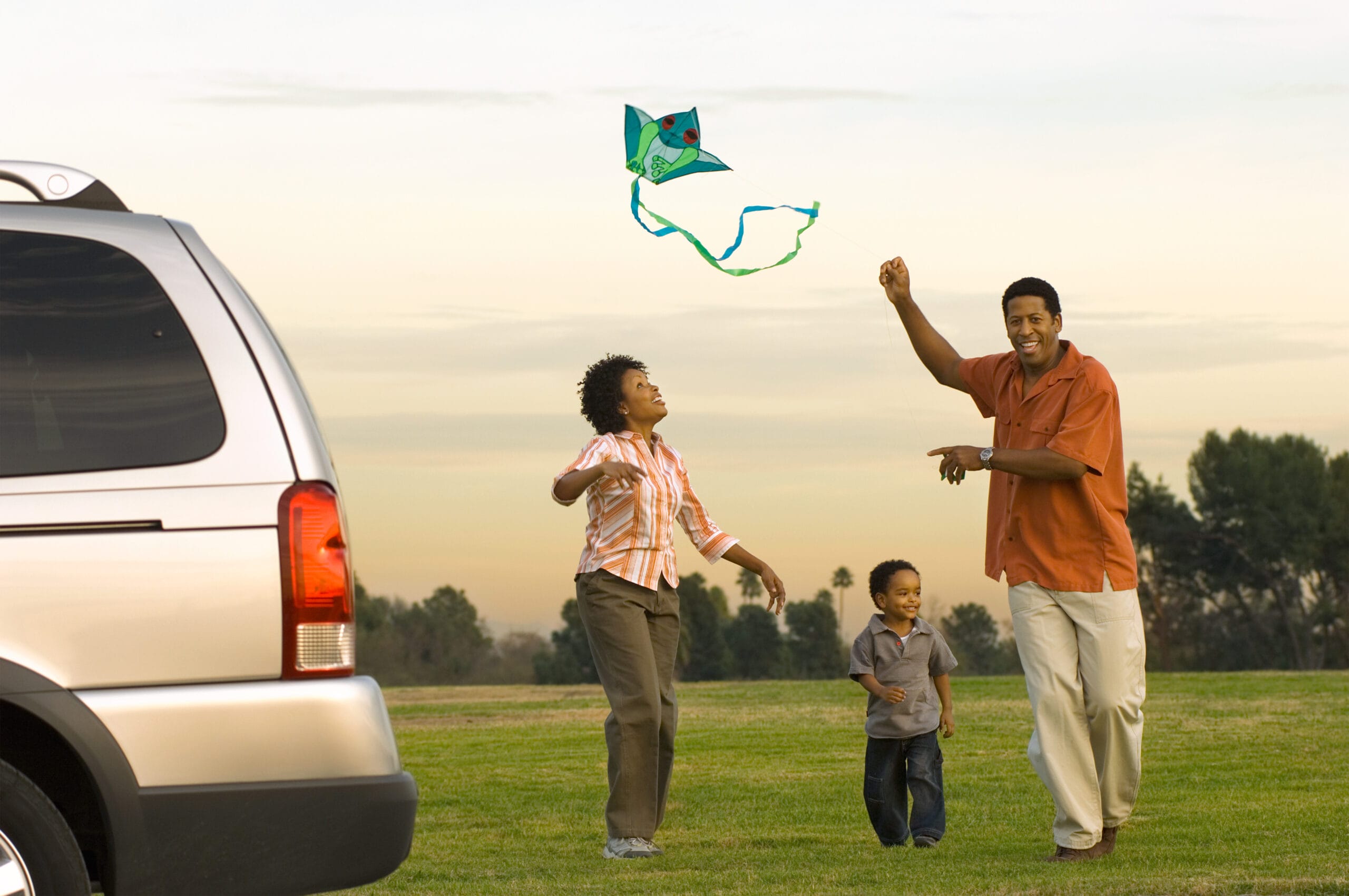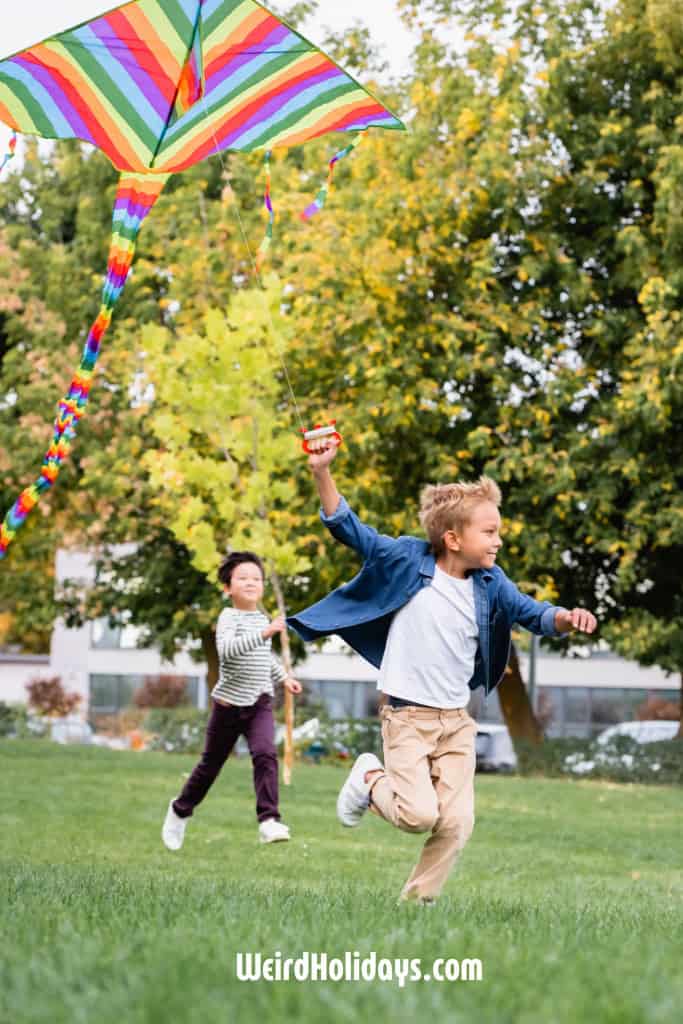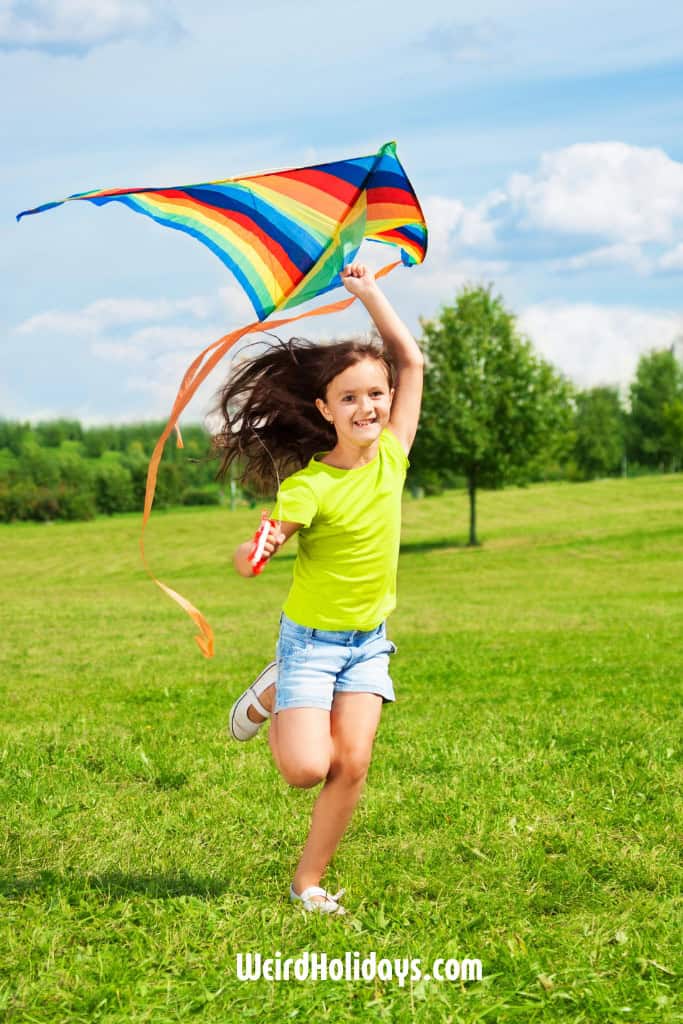National Kite Flying Day (February 8)

National Kite Flying Day, celebrated annually on February 8, is a delightful occasion to get outdoors and enjoy the simple pleasure of flying a kite.
This unique day is perfect for learning about the history of kites, exploring creative kite crafts, and embracing the joy of windy weather.
Plus, it’s one of the many unusual February holidays worth celebrating!
When is the Holiday?
National Kite Flying Day takes place on February 8th each year. Mark your calendars and get ready to hit the skies!
Who Invented It?
The origins of the holiday are a bit of a mystery, but kites themselves were invented in China around 470 B.C.
They were initially used for practical and ceremonial purposes before becoming the recreational activity we know today.
The History of the Holiday
Kites have a rich history spanning thousands of years. Ancient Chinese kites, crafted from bamboo and silk, served many purposes, from practical tools for fishing to symbolic instruments used for sending messages to the heavens.
Kites were believed to carry prayers or offerings to the gods, highlighting their spiritual and cultural significance.
In the 1200s, Marco Polo introduced kites to Europe, sparking curiosity and innovation across the continent. By the 18th century, kites were not just recreational toys but also scientific tools.
Benjamin Franklin famously used a kite to demonstrate the relationship between lightning and electricity in 1752, paving the way for advancements in electrical science.
Over time, kites transformed from functional objects to cherished symbols of creativity and leisure.
Today, they are celebrated worldwide, from competitive kite festivals in India to playful afternoons in parks and beaches, continuing to inspire joy and connection.

Top 5 Facts About Kites
- Kites originated in China over 2,000 years ago. The first kites were made from lightweight materials like bamboo and silk. They were used for a variety of purposes, including military signaling, fishing, and spiritual ceremonies. Some legends even suggest they were used to measure distances or lift observers for reconnaissance.
- Marco Polo brought kites to Europe during his travels. In the 1200s, Marco Polo introduced kites to Europe after witnessing their use in China. His accounts helped spark curiosity about the Asian invention, leading to their adaptation as both toys and tools across Europe.
- Benjamin Franklin used a kite to study electricity in 1752. Franklin’s famous experiment, where he flew a kite with a key attached to demonstrate the electrical nature of lightning, was groundbreaking. This experiment laid the groundwork for our understanding of electricity and its practical applications.
- The movie Mary Poppins popularized the song “Let’s Go Fly a Kite.” Released in 1964, Disney’s Mary Poppins featured the memorable song that helped solidify kite flying as a whimsical and joyful activity. The song remains iconic and often evokes nostalgia for family fun.
- In India, kites are flown competitively during the Kite Festival in January. Known as Uttarayan or Makar Sankranti, this festival marks the transition of the sun into Capricorn. It’s celebrated with vibrant kite competitions, where participants attempt to cut down rivals’ kites while enjoying traditional foods like sesame sweets and peanut brittle.
Activities to Celebrate
- Fly a kite at your favorite park or beach. Take advantage of a breezy day by heading to an open area like a park, field, or beach. Coastal locations are especially great due to strong and steady winds, making kite flying easier and more enjoyable.
- Make your own kite using simple materials like paper, sticks, and string. Crafting a kite is a fun activity for all ages. Use materials like colorful paper or fabric for the sail, lightweight sticks for the frame, and string for the line. Personalize your kite with markers, stickers, or streamers for a unique creation.
- Teach kids about the science of flight and wind resistance. Use kite flying as a hands-on lesson in aerodynamics. Explain how lift, drag, and wind resistance work together to keep a kite soaring in the sky. This is a great way to combine fun with learning.
- Host a kite-decorating competition with family and friends. Gather your loved ones for a creative contest. Provide plain kites or blank templates and let everyone decorate their own. Award prizes for the most creative, colorful, or unique designs before heading out to fly them.
- Learn about kite traditions from other cultures, like India’s Kite Festival. Explore how different cultures celebrate kite flying. For example, in India’s Kite Festival (Uttarayan), participants compete to cut each other’s kite strings. You can recreate a mini version of this event or enjoy traditional foods associated with kite festivals to celebrate globally.
These activities combine creativity, learning, and outdoor fun, making the day a memorable celebration.

**This post may contain affiliate links. As an Amazon Associate and a participant in other affiliate programs, I earn a commission on qualifying purchases.**
Links to Resources
- Buy a new kite. Find a variety of kites perfect for all ages, from simple diamond shapes to advanced stunt kites, and get ready to hit the skies.
- Kite Day Book for Kids. Discover this charming children’s book that brings the joy of kite flying to life with vibrant illustrations and a heartwarming story.
- K is for Kite Handprint Craft. A fun and creative craft perfect for young learners exploring the alphabet.
- How to Make a Paper Kite. Follow step-by-step instructions to build your own paper kite using simple household materials. Great for a hands-on activity with kids!
- Plastic Bag Kites. Learn how to turn an ordinary plastic bag into a functional and eco-friendly kite. A quick and easy project for windy days.
- Kite Popsicle Stick Craft. Perfect for younger kids, this craft uses popsicle sticks and colorful decorations to create mini kites that double as adorable keepsakes.
- Kindness Kites. Teach kids about kindness and social-emotional learning with this engaging activity. Sort “kind” and “unkind” actions with these interactive kites.
These resources offer a mix of practical guides, creative projects, and learning activities to make your National Kite Flying Day unforgettable.
Related Holidays
- National Umbrella Day (February 10)
- National Look Up to the Sky Day (April 14)
Pin it!
Share this post about kite flying on Pinterest!

